Planning and operation
Description of production cycles, preparation of plots, fertilization, planting, growing and harvesting.
Description of production cycles, preparation of plots and planting
In summary
the production cycles are as follows: for Morning glory and Water
mimosa some individuals specialise in the initial “nursery”
cultivation of the 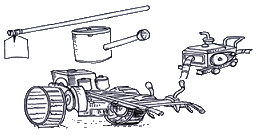 young plants (germ stems) on land, in well
irrigated small 100m² plots. In each of the 4 target cities these
individuals also maintain what they consider to be good cultivars of
each species, some of them swapping and updating their nursery
stocks between each other, and also at times going to collect new
stocks from wild growing plants outside the cities. However many of
the growout producers also maintain their own stocks and just
through vegetative growth of existing plants keep updating each
year. They are content to do this as long as their yields remain
high for market sales, however when these start to decline they then
go back to the specialist nurseries for new stocks.
young plants (germ stems) on land, in well
irrigated small 100m² plots. In each of the 4 target cities these
individuals also maintain what they consider to be good cultivars of
each species, some of them swapping and updating their nursery
stocks between each other, and also at times going to collect new
stocks from wild growing plants outside the cities. However many of
the growout producers also maintain their own stocks and just
through vegetative growth of existing plants keep updating each
year. They are content to do this as long as their yields remain
high for market sales, however when these start to decline they then
go back to the specialist nurseries for new stocks.
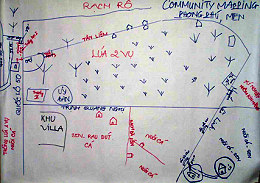 Before
they take the nursery stock from the land sites, the ongrowers will
prepare and fertilise their plots. Some initially spread lime CaOH
on the dried plot and then leave for one week to condition and to
some extent sterilise the soil. The plot is then filled up with
water, left for 2-3 days and then flushed out. The ongrowers don’t
actually want to encourage algal growth in their plots as this takes
away valuable nutrients which should be going solely into the
aquatic macrophytes production where they make their money.
Before
they take the nursery stock from the land sites, the ongrowers will
prepare and fertilise their plots. Some initially spread lime CaOH
on the dried plot and then leave for one week to condition and to
some extent sterilise the soil. The plot is then filled up with
water, left for 2-3 days and then flushed out. The ongrowers don’t
actually want to encourage algal growth in their plots as this takes
away valuable nutrients which should be going solely into the
aquatic macrophytes production where they make their money.
For morning glory - bundles of two to three germ stems are planted
in the plot in rows (early morning best time for planting). Around
20-30 cm is allowed between bundles of germ stems each other with
the width between each row set at around 2 metres.
Fertilization
Whilst not common in the three other cities which rely more on the nutrients coming from waste water, in Bangkok, a variety of chemical fertilizers (25-7-7 or 16-20-0) are first applied at a rate of 312kg per hectare after the first harvest, with this rate decreased into half after the fifth time of harvesting onwards. The frequency of fertilization and chemicals used is regularly practiced the day after each harvesting time which is estimated at one week intervals.
Growing period and harvesting
The total growing period of morning glory in Bangkok is around 90-105 days. During this period, the crop can be harvested 12-15 times. Early morning is the appropriate time for starting harvesting until at midday. Normally the apex of the stem around 40-60 cm below the top of the plant is cut using a knife. A set of 6-7 stems is put into a small bundle with a wooden stalk Around 25 of these small bundles are packed into one pile which is then wrapped with a clear plastic packaging sheet making an average weight of 5.5 kg per pile. Total gross yield is estimated to be 50.0 - 62.5 tons/ha/crop.

The table depicts seasons and important weather events relevant to the farms dealing with aquatic plants (Vietnam, Binh My village HCMC).
Variations in Production and Management
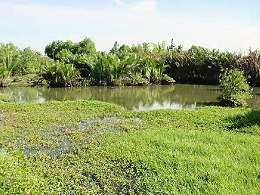 The four cities have differing production systems and management
practices for aquatic plants cultivation. In Hanoi due to seasonal
temperature differences there are 2 main species grown in the warmer
8 months, morning glory and water mimosa. Whilst water dropwort and
water cress are cultivated and sold in remaining four winter months.
The four cities have differing production systems and management
practices for aquatic plants cultivation. In Hanoi due to seasonal
temperature differences there are 2 main species grown in the warmer
8 months, morning glory and water mimosa. Whilst water dropwort and
water cress are cultivated and sold in remaining four winter months.
Essentially they are both grown in small demarcated plots of 0.05 hectares - former rice paddy fields which are irrigated with pumped urban waste water from adjacent canals (Hanoi has 5 waste water rivers) through controlled sluice gates three times a week to a depth of 0.5M in each plot. Productivities for morning glory range from 15 – 25 MT per hectare per year, with most being sold to district and local retail markets – often transported on small motorcycles.
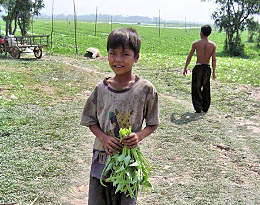 The other three warmer, more southerly cities grow
morning glory and water mimosa 12 months of the year. In HCMC in
larger 0.1 – 0.2 hectare plots again fed through a diffuse network
of waste water canals. In Phnom Penh in an urban wastewater fed
wetland - Beung Cheung EK lake - where local, lower income families
living on the banks of this sewage lake cultivate aquatic plants in
demarcated plots.
The other three warmer, more southerly cities grow
morning glory and water mimosa 12 months of the year. In HCMC in
larger 0.1 – 0.2 hectare plots again fed through a diffuse network
of waste water canals. In Phnom Penh in an urban wastewater fed
wetland - Beung Cheung EK lake - where local, lower income families
living on the banks of this sewage lake cultivate aquatic plants in
demarcated plots.
In the rainy season when water quality is good for
human consumption in the city, and in the dry season for urban
livestock feed. Bangkok has the most intensive of all production for
the four cities. It uses water from the cities hundreds of
irrigation and transport canals to feed larger 0.2 to 0.5 hectare
plots of morning, glory, water
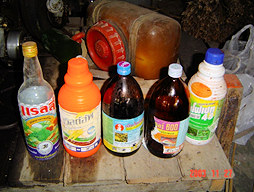 mimosa and some lotus production,
similarly in 0.75 – 1.2M deep water. Bangkok farmers though add
significant volumes of inorganic fertilizers and other chemicals to
increase yields and also control aquatic pests affecting their
crops. They are also packaging their products in polythene and
plastics to add value when they are subsequently sold to either
Bangkok’s 2 large wholesale markets or in some cases the farmers
sell directly to national chain supermarkets. This more intensive
system in Bangkok has higher input costs than the other cities but
as a result their plot productivities are higher – some reaching
over 100MT per hectare per year.
mimosa and some lotus production,
similarly in 0.75 – 1.2M deep water. Bangkok farmers though add
significant volumes of inorganic fertilizers and other chemicals to
increase yields and also control aquatic pests affecting their
crops. They are also packaging their products in polythene and
plastics to add value when they are subsequently sold to either
Bangkok’s 2 large wholesale markets or in some cases the farmers
sell directly to national chain supermarkets. This more intensive
system in Bangkok has higher input costs than the other cities but
as a result their plot productivities are higher – some reaching
over 100MT per hectare per year.